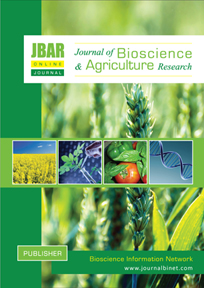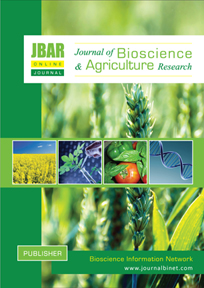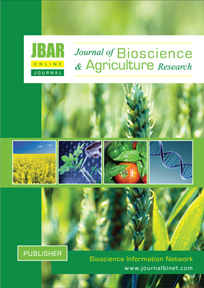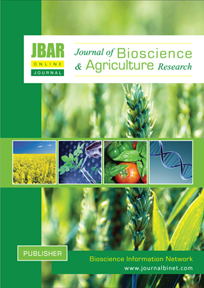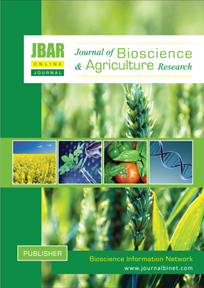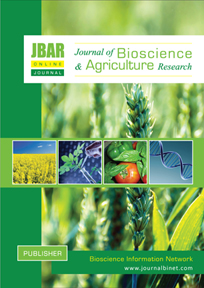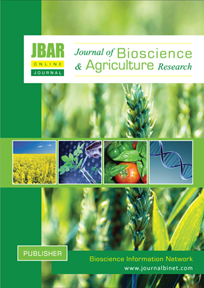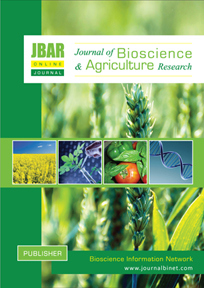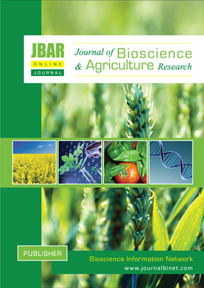Journal of Bioscience and Agriculture Research
Volume 09 - Issue 01 | Year of Publication: 2016
Article Type: Research Article | No. 91, 2016 | Country: Bangladesh | pp. 759-767 | Open Access
Title: Genetic diversity for reproductive traits of CMS restorer lines of rice (Oryza sativa L.)
Authors: Jesmin, R. & Mian, M. A. K.
DOI: http://dx.doi.org/10.18801/jbar.090116.91
Title: Genetic diversity for reproductive traits of CMS restorer lines of rice (Oryza sativa L.)
Authors: Jesmin, R. & Mian, M. A. K.
DOI: http://dx.doi.org/10.18801/jbar.090116.91
Title: Genetic diversity for reproductive traits of CMS restorer lines of rice (Oryza sativa L.)
Abstract: An experiment was conducted to study genetic divergence in 29 CMS restorer lines of rice. The study was carried out at the experimental farm, Dept. of Genetics and Plant Breeding, Bangabandhu Sheikh Mujibur Rahman Agricultural University, Gazipur during January, 2014 to June, 2014. Genetic divergence was estimated using D2 and principal component analysis. PCA showed 71.2 % variation against first Eigen values. From the scattered diagram it was revealed that the genotypes Acc-7386/ SHAKTI-1R, Acc-7394/ ACI-1R, Acc-7407/ CHINA-2R, Acc-7404/ HB-8R and Acc-7409/ 1R-509R were distantly located. Nonhierarchical clustering using co-variance matrix grouped 29 CMS restorer lines of rice into five different clusters. PCO showed that the highest inter genotype distance (2.422) was observed between the genotypes Acc-7386/ SHAKTI-1R and Acc-7394/ ACI-1R. The lowest distance (0.458) was observed between the genotypes Acc-7396/ LP-106R and Acc-7397/ LP-108R. The genotypes of cluster II exhibited the highest mean value for 11 out of 21 characters studied followed by cluster V exhibited the highest mean value for 5 out of 21 characters studied. The genotypes of cluster I exhibited the lowest mean value for 8 out of 21 characters studied followed by cluster IV exhibited the lowest mean value for 6 out of 21 characters studied. There were marked variations in intra-cluster distances, which ranged from 0.000 to 1.066. Considering magnitude of genetic distance, contribution of different characters towards the total divergence, magnitude of cluster means for different characters and performance of the genotypes Acc-7386/ SHAKTI-1R, Acc-7394/ ACI-1R, Acc-7407/ CHINA-2R, Acc-7404/ HB-8R and Acc-7409/ 1R-509R might be selected for further hybrid breeding program.
Key Words: Eigen value, Cluster means, Divergence, Non-hierarchical clustering and D2 analysis
Abstract: An experiment was conducted to study genetic divergence in 29 CMS restorer lines of rice. The study was carried out at the experimental farm, Dept. of Genetics and Plant Breeding, Bangabandhu Sheikh Mujibur Rahman Agricultural University, Gazipur during January, 2014 to June, 2014. Genetic divergence was estimated using D2 and principal component analysis. PCA showed 71.2 % variation against first Eigen values. From the scattered diagram it was revealed that the genotypes Acc-7386/ SHAKTI-1R, Acc-7394/ ACI-1R, Acc-7407/ CHINA-2R, Acc-7404/ HB-8R and Acc-7409/ 1R-509R were distantly located. Nonhierarchical clustering using co-variance matrix grouped 29 CMS restorer lines of rice into five different clusters. PCO showed that the highest inter genotype distance (2.422) was observed between the genotypes Acc-7386/ SHAKTI-1R and Acc-7394/ ACI-1R. The lowest distance (0.458) was observed between the genotypes Acc-7396/ LP-106R and Acc-7397/ LP-108R. The genotypes of cluster II exhibited the highest mean value for 11 out of 21 characters studied followed by cluster V exhibited the highest mean value for 5 out of 21 characters studied. The genotypes of cluster I exhibited the lowest mean value for 8 out of 21 characters studied followed by cluster IV exhibited the lowest mean value for 6 out of 21 characters studied. There were marked variations in intra-cluster distances, which ranged from 0.000 to 1.066. Considering magnitude of genetic distance, contribution of different characters towards the total divergence, magnitude of cluster means for different characters and performance of the genotypes Acc-7386/ SHAKTI-1R, Acc-7394/ ACI-1R, Acc-7407/ CHINA-2R, Acc-7404/ HB-8R and Acc-7409/ 1R-509R might be selected for further hybrid breeding program.
Key Words: Eigen value, Cluster means, Divergence, Non-hierarchical clustering and D2 analysis
APA (American Psychological Association)
Jesmin, R. & Mian, M. A. K. (2016). Genetic diversity for reproductive traits of CMS restorer lines of rice (Oryza sativa L.). Journal of Bioscience and Agriculture Research, 09(01), 759-767.
MLA (Modern Language Association)
Jesmin, R. & Mian, M. A. K. "Genetic diversity for reproductive traits of CMS restorer lines of rice (Oryza sativa L.)." Journal of Bioscience and Agriculture Research, 09.01 (2016), 759-767.
Chicago/Turabian
Jesmin, R. & Mian, M. A. K. Genetic diversity for reproductive traits of CMS restorer lines of rice (Oryza sativa L.). Journal of Bioscience and Agriculture Research, 09, no. 01 (2016), 759-767.
Jesmin, R. & Mian, M. A. K. (2016). Genetic diversity for reproductive traits of CMS restorer lines of rice (Oryza sativa L.). Journal of Bioscience and Agriculture Research, 09(01), 759-767.
MLA (Modern Language Association)
Jesmin, R. & Mian, M. A. K. "Genetic diversity for reproductive traits of CMS restorer lines of rice (Oryza sativa L.)." Journal of Bioscience and Agriculture Research, 09.01 (2016), 759-767.
Chicago/Turabian
Jesmin, R. & Mian, M. A. K. Genetic diversity for reproductive traits of CMS restorer lines of rice (Oryza sativa L.). Journal of Bioscience and Agriculture Research, 09, no. 01 (2016), 759-767.
Article Type: Research Article | No. 92, 2016 | Country: Bangladesh | pp. 768-774 | Open Access
Title: Genetic study and selection in F4 generation of rice (Oryza sativa L.)
Authors: Rai, P. K., Sarker, U. K., Islam, A. K. M. S., Rahman, M. A. & Hasan, M.
DOI: http://dx.doi.org/10.18801/jbar.090116.92
Title: Genetic study and selection in F4 generation of rice (Oryza sativa L.)
Authors: Rai, P. K., Sarker, U. K., Islam, A. K. M. S., Rahman, M. A. & Hasan, M.
DOI: http://dx.doi.org/10.18801/jbar.090116.92
Title: Genetic study and selection in F4 generation of rice (Oryza sativa L.)
Abstract: An attempt was made to study the variability in 25 F4 generation of T. Aman rice. Highly significant variations were obtained for all the characters studied. The highest mean and range value was observed for grain yield per meter square followed by number of filled grains per panicle, spikelet sterility (%) and 1000-grain weight. Highest genotypic variance was observed for grain yield per meter square followed by plant height, number of filled grains per panicle and spikelet sterility (%) whereas the highest genotypic coefficient of variation was recorded for spikelet sterility (%) followed by grain yield per meter square, panicle weight and plant height. Phenotypic variance was close to the corresponding genotypic variance for all the traits studied except plant height, panicle size, weight and branching habit. On the other hand, all the characters showed close phenotypic and genotypic coefficient of variation except panicle weight and spikelet sterility (%) which indicated additive gene action for expression of the characters. Considering mean, range and all genetic parameters selection could be performed on the basis of number of tillers per hill, number of panicles per hill, panicle length, number of filled grains per panicle, spikelet sterility (%), 1000-grain weight and grain yield per square meter for significantly improvement of rice yield.
Key Words: Heritability, Variability, Selection, F4 Generation and Rice (Oryza sativa L.)
Abstract: An attempt was made to study the variability in 25 F4 generation of T. Aman rice. Highly significant variations were obtained for all the characters studied. The highest mean and range value was observed for grain yield per meter square followed by number of filled grains per panicle, spikelet sterility (%) and 1000-grain weight. Highest genotypic variance was observed for grain yield per meter square followed by plant height, number of filled grains per panicle and spikelet sterility (%) whereas the highest genotypic coefficient of variation was recorded for spikelet sterility (%) followed by grain yield per meter square, panicle weight and plant height. Phenotypic variance was close to the corresponding genotypic variance for all the traits studied except plant height, panicle size, weight and branching habit. On the other hand, all the characters showed close phenotypic and genotypic coefficient of variation except panicle weight and spikelet sterility (%) which indicated additive gene action for expression of the characters. Considering mean, range and all genetic parameters selection could be performed on the basis of number of tillers per hill, number of panicles per hill, panicle length, number of filled grains per panicle, spikelet sterility (%), 1000-grain weight and grain yield per square meter for significantly improvement of rice yield.
Key Words: Heritability, Variability, Selection, F4 Generation and Rice (Oryza sativa L.)
APA (American Psychological Association)
Rai, P. K., Sarker, U. K., Islam, A. K. M. S., Rahman, M. A. & Hasan, M. (2016). Genetic study and selection in F4 generation of rice (Oryza sativa L.). Journal of Bioscience and Agriculture Research, 09(01), 768-774.
MLA (Modern Language Association)
Rai, P. K., Sarker, U. K., Islam, A. K. M. S., Rahman, M. A. & Hasan, M. "Genetic study and selection in F4 generation of rice (Oryza sativa L.)." Journal of Bioscience and Agriculture Research, 09.01 (2016), 768-774.
Chicago/Turabian
Rai, P. K., Sarker, U. K., Islam, A. K. M. S., Rahman, M. A. & Hasan, M. Genetic study and selection in F4 generation of rice (Oryza sativa L.). Journal of Bioscience and Agriculture Research, 09, no. 01 (2016), 768-774.
Rai, P. K., Sarker, U. K., Islam, A. K. M. S., Rahman, M. A. & Hasan, M. (2016). Genetic study and selection in F4 generation of rice (Oryza sativa L.). Journal of Bioscience and Agriculture Research, 09(01), 768-774.
MLA (Modern Language Association)
Rai, P. K., Sarker, U. K., Islam, A. K. M. S., Rahman, M. A. & Hasan, M. "Genetic study and selection in F4 generation of rice (Oryza sativa L.)." Journal of Bioscience and Agriculture Research, 09.01 (2016), 768-774.
Chicago/Turabian
Rai, P. K., Sarker, U. K., Islam, A. K. M. S., Rahman, M. A. & Hasan, M. Genetic study and selection in F4 generation of rice (Oryza sativa L.). Journal of Bioscience and Agriculture Research, 09, no. 01 (2016), 768-774.
Article Type: Research Article | No. 93, 2016 | Country: Bangladesh | pp. 775-781 | Open Access
Title: Range of various fungal infections to local and hybrid varieties of non-germinated lentil seed in Bangladesh
Authors: Azad, S. A., Mamun, M. A. A., Mondal, K. J., Alim, S. & Rahman, M. M. (2016)
DOI: http://dx.doi.org/10.18801/jbar.090116.93
Title: Range of various fungal infections to local and hybrid varieties of non-germinated lentil seed in Bangladesh
Authors: Azad, S. A., Mamun, M. A. A., Mondal, K. J., Alim, S. & Rahman, M. M. (2016)
DOI: http://dx.doi.org/10.18801/jbar.090116.93
Title: Range of various fungal infections to local and hybrid varieties of non-germinated lentil seed in Bangladesh
Abstract: To estimate fungal infection range in local and hybrid lentil seed varieties in Bangladesh this study was implemented stepwise. After collecting healthy and qualified lentil seeds from different location of Bangladesh, purity test was scrutinized as well as germination capability of seeds was also checked through blotter incubation method. Non-germinated seeds were then observed under stereo binocular microscope firstly and then on sophisticated camera attached light microscope to identify which fungus species infected them. 15 local and 15 hybrid varieties were taken and there were different varieties of fungal infection happened. Five of the fungal species infected local varieties whereas five species attacked hybrid varieties. As Bangladesh is agriculture depended country and lentil is one of the important crops in our country, farmers will be awarded of which fungal varieties are responsible for lentil seed infection through this study and can increase lentil production by applying appropriate bio-fertilizer against specific fungal species.
Key Words: Lentil seed, Local and Hybrid varieties, Germination capability and Fungi infection
Abstract: To estimate fungal infection range in local and hybrid lentil seed varieties in Bangladesh this study was implemented stepwise. After collecting healthy and qualified lentil seeds from different location of Bangladesh, purity test was scrutinized as well as germination capability of seeds was also checked through blotter incubation method. Non-germinated seeds were then observed under stereo binocular microscope firstly and then on sophisticated camera attached light microscope to identify which fungus species infected them. 15 local and 15 hybrid varieties were taken and there were different varieties of fungal infection happened. Five of the fungal species infected local varieties whereas five species attacked hybrid varieties. As Bangladesh is agriculture depended country and lentil is one of the important crops in our country, farmers will be awarded of which fungal varieties are responsible for lentil seed infection through this study and can increase lentil production by applying appropriate bio-fertilizer against specific fungal species.
Key Words: Lentil seed, Local and Hybrid varieties, Germination capability and Fungi infection
APA (American Psychological Association)
Azad, S. A., Mamun, M. A. A., Mondal, K. J., Alim, S. & Rahman, M. M. (2016). Range of various fungal infections to local and hybrid varieties of non-germinated lentil seed in Bangladesh. Journal of Bioscience and Agriculture Research, 09(01), 775-781.
MLA (Modern Language Association)
Azad, S. A., Mamun, M. A. A., Mondal, K. J., Alim, S. & Rahman, M. M. "Range of various fungal infections to local and hybrid varieties of non-germinated lentil seed in Bangladesh." Journal of Bioscience and Agriculture Research, 09.01 (2016), 775-781.
Chicago/Turabian
Azad, S. A., Mamun, M. A. A., Mondal, K. J., Alim, S. & Rahman, M. M. Range of various fungal infections to local and hybrid varieties of non-germinated lentil seed in Bangladesh. Journal of Bioscience and Agriculture Research, 09, no. 01 (2016), 775-781.
Azad, S. A., Mamun, M. A. A., Mondal, K. J., Alim, S. & Rahman, M. M. (2016). Range of various fungal infections to local and hybrid varieties of non-germinated lentil seed in Bangladesh. Journal of Bioscience and Agriculture Research, 09(01), 775-781.
MLA (Modern Language Association)
Azad, S. A., Mamun, M. A. A., Mondal, K. J., Alim, S. & Rahman, M. M. "Range of various fungal infections to local and hybrid varieties of non-germinated lentil seed in Bangladesh." Journal of Bioscience and Agriculture Research, 09.01 (2016), 775-781.
Chicago/Turabian
Azad, S. A., Mamun, M. A. A., Mondal, K. J., Alim, S. & Rahman, M. M. Range of various fungal infections to local and hybrid varieties of non-germinated lentil seed in Bangladesh. Journal of Bioscience and Agriculture Research, 09, no. 01 (2016), 775-781.
Article Type: Research Article | No. 94, 2016 | Country: Bangladesh | pp. 782-791 | Open Access
Title: Performance of eight tomato mutants in winter season
Authors: Ghosh, S., Khan, M. H., Saha, K. C., Azam, M. G. & Pramanik, M. H. R. (2016)
DOI: http://dx.doi.org/10.18801/jbar.090116.94
Title: Performance of eight tomato mutants in winter season
Authors: Ghosh, S., Khan, M. H., Saha, K. C., Azam, M. G. & Pramanik, M. H. R. (2016)
DOI: http://dx.doi.org/10.18801/jbar.090116.94
Title: Performance of eight tomato mutants in winter season
Abstract: Eight tomato mutants (TM-113, TM-127, TM-128, TM-131, TM-132, TM-133, TM-134 and TM- 160) along with two reference varieties (Binatomato-4, Binatomato-5) were evaluated based on their morpho-physiological features, reproductive characters, yield attributes and fruit yield at the experimental farm of Bangladesh Institute of Nuclear Agriculture (BINA). The experiment was laid out in a randomized complete block design with three replications. The mutants differed significantly from their morphological features (plant height, branch and leaf number, leaf area, etc.), growth characters (root weight and total dry mass plant-1, absolute and relative growth rate), biochemical parameters (chlorophyll, total sugar, nitrate reductase and vitamin-C contents), reproductive behaviour (number of effective and non-effective flower cluster plant-1, number of flowers plant-1 and reproductive efficiency), yield attributes and fruit yield. Superior performance in leaf area, total dry mass production, absolute growth rate, nitrate reductase activity and total sugar content in leaves, number of flower cluster and flowers plant-1 which resulted higher number of fruits plant-1. Chlorophyll content and reproductive efficiency had little or no significant contribution to fruit yield. Fruit yield had highly significant positive correlation with leaf area, total dry mass, absolute growth rate, number of flower clusters and fruits plant-1, while fruit size had significant negative association with fruit number. This result indicates that the improvement of fruit number plant-1 could be achieved by selecting increased number of effective flower cluster plant-1. The mutant, TM-133 maintained superiority to the other mutants for yield related traits and produced highest fruit yield (95.1 t ha-1) and thus, it may be treated as a promising mutant to release as variety.
Key Words: Tomato, Mutant, Binatomato, Yield, Genotype and Variety
Abstract: Eight tomato mutants (TM-113, TM-127, TM-128, TM-131, TM-132, TM-133, TM-134 and TM- 160) along with two reference varieties (Binatomato-4, Binatomato-5) were evaluated based on their morpho-physiological features, reproductive characters, yield attributes and fruit yield at the experimental farm of Bangladesh Institute of Nuclear Agriculture (BINA). The experiment was laid out in a randomized complete block design with three replications. The mutants differed significantly from their morphological features (plant height, branch and leaf number, leaf area, etc.), growth characters (root weight and total dry mass plant-1, absolute and relative growth rate), biochemical parameters (chlorophyll, total sugar, nitrate reductase and vitamin-C contents), reproductive behaviour (number of effective and non-effective flower cluster plant-1, number of flowers plant-1 and reproductive efficiency), yield attributes and fruit yield. Superior performance in leaf area, total dry mass production, absolute growth rate, nitrate reductase activity and total sugar content in leaves, number of flower cluster and flowers plant-1 which resulted higher number of fruits plant-1. Chlorophyll content and reproductive efficiency had little or no significant contribution to fruit yield. Fruit yield had highly significant positive correlation with leaf area, total dry mass, absolute growth rate, number of flower clusters and fruits plant-1, while fruit size had significant negative association with fruit number. This result indicates that the improvement of fruit number plant-1 could be achieved by selecting increased number of effective flower cluster plant-1. The mutant, TM-133 maintained superiority to the other mutants for yield related traits and produced highest fruit yield (95.1 t ha-1) and thus, it may be treated as a promising mutant to release as variety.
Key Words: Tomato, Mutant, Binatomato, Yield, Genotype and Variety
APA (American Psychological Association)
Ghosh, S., Khan, M. H., Saha, K. C., Azam, M. G. & Pramanik, M. H. R. (2016). Performance of eight tomato mutants in winter season. Journal of Bioscience and Agriculture Research, 09(01), 782-791.
MLA (Modern Language Association)
Ghosh, S., Khan, M. H., Saha, K. C., Azam, M. G. & Pramanik, M. H. R. "Performance of eight tomato mutants in winter season." Journal of Bioscience and Agriculture Research, 09.01 (2016), 782-791.
Chicago/Turabian
Ghosh, S., Khan, M. H., Saha, K. C., Azam, M. G. & Pramanik, M. H. R. Performance of eight tomato mutants in winter season. Journal of Bioscience and Agriculture Research, 09, no. 01 (2016), 782-791.
Ghosh, S., Khan, M. H., Saha, K. C., Azam, M. G. & Pramanik, M. H. R. (2016). Performance of eight tomato mutants in winter season. Journal of Bioscience and Agriculture Research, 09(01), 782-791.
MLA (Modern Language Association)
Ghosh, S., Khan, M. H., Saha, K. C., Azam, M. G. & Pramanik, M. H. R. "Performance of eight tomato mutants in winter season." Journal of Bioscience and Agriculture Research, 09.01 (2016), 782-791.
Chicago/Turabian
Ghosh, S., Khan, M. H., Saha, K. C., Azam, M. G. & Pramanik, M. H. R. Performance of eight tomato mutants in winter season. Journal of Bioscience and Agriculture Research, 09, no. 01 (2016), 782-791.
Article Type: Research Article | No. 95, 2016 | Country: Bangladesh | pp. 792-795 | Open Access
Title: Stages of vine pruning for vine production of bottle gourd varieties and lines in summer season
Authors: Ali, M. R., Halim, G. M. A. & Mehraj, H. (2016)
DOI: http://dx.doi.org/10.18801/jbar.090116.95
Title: Stages of vine pruning for vine production of bottle gourd varieties and lines in summer season
Authors: Ali, M. R., Halim, G. M. A. & Mehraj, H. (2016)
DOI: http://dx.doi.org/10.18801/jbar.090116.95
Title: Stages of vine pruning for vine production of bottle gourd varieties and lines in summer season
Abstract: Four bottle gourd varieties and lines (V1: BARI Lau-3, V2: BARI Lau-4, V3: LS 0012-5-3 and V4: LS 0026-5-3) and three pruning stages (P1: Pruning at two vine stage, P2: Pruning at 3 vine stage and P3: Pruning at 4 vine stage) were implied to observe the effect of pruning on the maximization of vine production in bottle gourd. V4 produced maximum number of vine (117.2/plant) and highest vine yield (10.2 t/ha) among four varieties while P3 produced maximum number of vine (109.2/plant) and highest vine yield (9.1 t/ha) among three pruning techniques. The maximum number of harvested vine (118.0/plant) and highest vine yield (10.73 t/ha) was found from V4P3 which was statistically followed by V4P1 and the lowest vine yield was recorded from V2P1 (6.62 t/ha). LS 0026-5-3 along with pruning of terminal shoots four vine stages can be recommended for better vine production in bottle gourd for use as leafy vegetable.
Key Words: Lagenaria siceraria, Pruning, Varieties & lines vine and Yield
Abstract: Four bottle gourd varieties and lines (V1: BARI Lau-3, V2: BARI Lau-4, V3: LS 0012-5-3 and V4: LS 0026-5-3) and three pruning stages (P1: Pruning at two vine stage, P2: Pruning at 3 vine stage and P3: Pruning at 4 vine stage) were implied to observe the effect of pruning on the maximization of vine production in bottle gourd. V4 produced maximum number of vine (117.2/plant) and highest vine yield (10.2 t/ha) among four varieties while P3 produced maximum number of vine (109.2/plant) and highest vine yield (9.1 t/ha) among three pruning techniques. The maximum number of harvested vine (118.0/plant) and highest vine yield (10.73 t/ha) was found from V4P3 which was statistically followed by V4P1 and the lowest vine yield was recorded from V2P1 (6.62 t/ha). LS 0026-5-3 along with pruning of terminal shoots four vine stages can be recommended for better vine production in bottle gourd for use as leafy vegetable.
Key Words: Lagenaria siceraria, Pruning, Varieties & lines vine and Yield
APA (American Psychological Association)
Ali, M. R., Halim, G. M. A. & Mehraj, H. (2016). Stages of Vine pruning for vine production of bottle gourd varieties and lines in summer season. Journal of Bioscience and Agriculture Research, 09(01), 792-795.
MLA (Modern Language Association)
Ali, M. R., Halim, G. M. A. & Mehraj, H. "Stages of Vine pruning for vine production of bottle gourd varieties and lines in summer season." Journal of Bioscience and Agriculture Research, 09.01 (2016), 792-795.
Chicago/Turabian
Ali, M. R., Halim, G. M. A. & Mehraj, H. Stages of Vine pruning for vine production of bottle gourd varieties and lines in summer season. Journal of Bioscience and Agriculture Research, 09, no. 01 (2016), 792-795.
Ali, M. R., Halim, G. M. A. & Mehraj, H. (2016). Stages of Vine pruning for vine production of bottle gourd varieties and lines in summer season. Journal of Bioscience and Agriculture Research, 09(01), 792-795.
MLA (Modern Language Association)
Ali, M. R., Halim, G. M. A. & Mehraj, H. "Stages of Vine pruning for vine production of bottle gourd varieties and lines in summer season." Journal of Bioscience and Agriculture Research, 09.01 (2016), 792-795.
Chicago/Turabian
Ali, M. R., Halim, G. M. A. & Mehraj, H. Stages of Vine pruning for vine production of bottle gourd varieties and lines in summer season. Journal of Bioscience and Agriculture Research, 09, no. 01 (2016), 792-795.
Volume 09 - Issue 02 | Year of Publication: 2016
Article Type: Research Article | No. 96, 2016 | Country: Bangladesh | pp. 796-803 | Open Access
Title: Callus induction and efficient plant regeneration in Cucumber (Cucumis sativus L.)
Authors: Jesmin, R. & Mian, M. A. K. (2016)
DOI: http://dx.doi.org/10.18801/jbar.090216.96
Title: Callus induction and efficient plant regeneration in Cucumber (Cucumis sativus L.)
Authors: Jesmin, R. & Mian, M. A. K. (2016)
DOI: http://dx.doi.org/10.18801/jbar.090216.96
Title: Callus induction and efficient plant regeneration in Cucumber (Cucumis sativus L.)
Abstract: A reliable and reproducible protocol is established to get healthy and wellformed callus from juvenile explants of cucumber. The sterilized seeds of cucumber cultivar were cultured on MS basal medium (Murashige and Skoog, 1962). The seeds germinated after 7 days of culture with 24 hours dark photoperiod. Explants from germinated seedlings were cultured on MS medium supplemented with individual treatments of different auxins (2,4-dichloro-phenoxyacetic acid (2,4-D), α naphthalene acetic acid (NAA)) or cytokinins (benzyl aminopurine (BAP)). Plant parts such as leaves, stems and cotyledons were used as source of explants. Callus were initiated from leaves, stems and cotyledons after 4 weeks of culture. The optimum medium for callus induction from leave, stem and cotyledon explants was MS medium supplemented with 0.5 mg/L BAP added with 1.0 mg/L NAA. The highest percentage of callus was obtained from stem explants (89.0 ± 0.75 %) followed by leave (79.05 ± 3.28%) and cotyledon (74.43 ± 1.30 %) explants. Maximum callus induction in stems (73.05 ± 2.1%) was obtained in 1.mg/l concentration of BAP. Incorporating 2,4-D in the callus induction media promoted slow callus growth and low quality callus compared to that produced on media containing NAA and BAP. Callus induced on media containing 2,4-D was friable and yellow in color. This protocol can promote the application of tissue culture technology to facilitate the genetic transformation of this species.
Key Words: Cotyledon, Naphatalene acetic acid, Benzylaminopurine, propagation and Explants
Abstract: A reliable and reproducible protocol is established to get healthy and wellformed callus from juvenile explants of cucumber. The sterilized seeds of cucumber cultivar were cultured on MS basal medium (Murashige and Skoog, 1962). The seeds germinated after 7 days of culture with 24 hours dark photoperiod. Explants from germinated seedlings were cultured on MS medium supplemented with individual treatments of different auxins (2,4-dichloro-phenoxyacetic acid (2,4-D), α naphthalene acetic acid (NAA)) or cytokinins (benzyl aminopurine (BAP)). Plant parts such as leaves, stems and cotyledons were used as source of explants. Callus were initiated from leaves, stems and cotyledons after 4 weeks of culture. The optimum medium for callus induction from leave, stem and cotyledon explants was MS medium supplemented with 0.5 mg/L BAP added with 1.0 mg/L NAA. The highest percentage of callus was obtained from stem explants (89.0 ± 0.75 %) followed by leave (79.05 ± 3.28%) and cotyledon (74.43 ± 1.30 %) explants. Maximum callus induction in stems (73.05 ± 2.1%) was obtained in 1.mg/l concentration of BAP. Incorporating 2,4-D in the callus induction media promoted slow callus growth and low quality callus compared to that produced on media containing NAA and BAP. Callus induced on media containing 2,4-D was friable and yellow in color. This protocol can promote the application of tissue culture technology to facilitate the genetic transformation of this species.
Key Words: Cotyledon, Naphatalene acetic acid, Benzylaminopurine, propagation and Explants
APA (American Psychological Association)
Jesmin, R. & Mian, M. A. K. (2016). Callus induction and efficient plant regeneration in Cucumber (Cucumis sativus L.). Journal of Bioscience and Agriculture Research, 09(02), 796-803.
MLA (Modern Language Association)
Jesmin, R. & Mian, M. A. K. "Callus induction and efficient plant regeneration in Cucumber (Cucumis sativus L.)." Journal of Bioscience and Agriculture Research, 09.02 (2016), 796-803.
Chicago/Turabian
Jesmin, R. & Mian, M. A. K. Callus induction and efficient plant regeneration in Cucumber (Cucumis sativus L.). Journal of Bioscience and Agriculture Research, 09, no. 02 (2016), 796-803.
Jesmin, R. & Mian, M. A. K. (2016). Callus induction and efficient plant regeneration in Cucumber (Cucumis sativus L.). Journal of Bioscience and Agriculture Research, 09(02), 796-803.
MLA (Modern Language Association)
Jesmin, R. & Mian, M. A. K. "Callus induction and efficient plant regeneration in Cucumber (Cucumis sativus L.)." Journal of Bioscience and Agriculture Research, 09.02 (2016), 796-803.
Chicago/Turabian
Jesmin, R. & Mian, M. A. K. Callus induction and efficient plant regeneration in Cucumber (Cucumis sativus L.). Journal of Bioscience and Agriculture Research, 09, no. 02 (2016), 796-803.
Article Type: Research Article | No. 97, 2016 | Country: Bangladesh | pp. 804-811 | Open Access
Title: Effects of floral preservative solutions for vase life evaluation of Gerbera
Authors: Mehraj, H., Shiam, I. H., Taufique, T., Shamsuzzoha, M. & Jamal Uddin, A. F. M. (2016)
DOI: http://dx.doi.org/10.18801/jbar.090216.97
Title: Effects of floral preservative solutions for vase life evaluation of Gerbera
Authors: Mehraj, H., Shiam, I. H., Taufique, T., Shamsuzzoha, M. & Jamal Uddin, A. F. M. (2016)
DOI: http://dx.doi.org/10.18801/jbar.090216.97
Title: Effects of floral preservative solutions for vase life evaluation of Gerbera
Abstract: An experiment was conducted to evaluate the postharvest life of cut gerbera cultivars under the different preservative solutions. Three (yellow, magenta and orange) cut gerbera cultivars were placed on nine different preservative solution viz. T1: Control; T2: Sugar (100-ppm); T3: Citric Acid (100-ppm); T4: Salicylic Acid (100-ppm); T5: Chitosa (100-ppm); T6: Sugar + Citric Acid (100-ppm); T7: Sugar + Salicylic Acid (100-ppm); T8: Citric Acid + Chitosan (100-ppm); T9: Salicylic Acid + Chitosan (100-ppm) following completely randomized design. Yellow gerbera provided the maximum petals water content (52.4%) when placed in T9 and also provided 8.0 days more vase life compared to the control. For magenta and orange gerbera, maximum petals water content (magenta: 56.3% and orange: 63.0%) in T8 and also 6.9 days more vase life than control.
Key Words: Gerbera cultivars, Preservative solutions and Vase life
Abstract: An experiment was conducted to evaluate the postharvest life of cut gerbera cultivars under the different preservative solutions. Three (yellow, magenta and orange) cut gerbera cultivars were placed on nine different preservative solution viz. T1: Control; T2: Sugar (100-ppm); T3: Citric Acid (100-ppm); T4: Salicylic Acid (100-ppm); T5: Chitosa (100-ppm); T6: Sugar + Citric Acid (100-ppm); T7: Sugar + Salicylic Acid (100-ppm); T8: Citric Acid + Chitosan (100-ppm); T9: Salicylic Acid + Chitosan (100-ppm) following completely randomized design. Yellow gerbera provided the maximum petals water content (52.4%) when placed in T9 and also provided 8.0 days more vase life compared to the control. For magenta and orange gerbera, maximum petals water content (magenta: 56.3% and orange: 63.0%) in T8 and also 6.9 days more vase life than control.
Key Words: Gerbera cultivars, Preservative solutions and Vase life
APA (American Psychological Association)
Mehraj, H., Shiam, I. H., Taufique, T., Shamsuzzoha, M. & Jamal Uddin, A. F. M. (2016). Effects of floral preservative solutions for vase life evaluation of Gerbera. Journal of Bioscience and Agriculture Research, 09(02), 804-811.
MLA (Modern Language Association)
Mehraj, H., Shiam, I. H., Taufique, T., Shamsuzzoha, M. & Jamal Uddin, A. F. M. "Effects of floral preservative solutions for vase life evaluation of Gerbera." Journal of Bioscience and Agriculture Research, 09.02 (2016), 804-811.
Chicago/Turabian
Mehraj, H., Shiam, I. H., Taufique, T., Shamsuzzoha, M. & Jamal Uddin, A. F. M. Effects of floral preservative solutions for vase life evaluation of Gerbera. Journal of Bioscience and Agriculture Research, 09, no. 02 (2016), 804-811.
Mehraj, H., Shiam, I. H., Taufique, T., Shamsuzzoha, M. & Jamal Uddin, A. F. M. (2016). Effects of floral preservative solutions for vase life evaluation of Gerbera. Journal of Bioscience and Agriculture Research, 09(02), 804-811.
MLA (Modern Language Association)
Mehraj, H., Shiam, I. H., Taufique, T., Shamsuzzoha, M. & Jamal Uddin, A. F. M. "Effects of floral preservative solutions for vase life evaluation of Gerbera." Journal of Bioscience and Agriculture Research, 09.02 (2016), 804-811.
Chicago/Turabian
Mehraj, H., Shiam, I. H., Taufique, T., Shamsuzzoha, M. & Jamal Uddin, A. F. M. Effects of floral preservative solutions for vase life evaluation of Gerbera. Journal of Bioscience and Agriculture Research, 09, no. 02 (2016), 804-811.
Article Type: Research Article | No. 98 | Country: Bangladesh | pp. 812-819 | Open Access
Title: Classification and evaluation of gerbera cultivars
Authors: Mehraj, H., Taufique, T., Parvin, S., Shamsuzzoha, M. & Jamal Uddin, A. F. M. (2016)
DOI: http://dx.doi.org/10.18801/jbar.090216.98
Title: Classification and evaluation of gerbera cultivars
Authors: Mehraj, H., Taufique, T., Parvin, S., Shamsuzzoha, M. & Jamal Uddin, A. F. M. (2016)
DOI: http://dx.doi.org/10.18801/jbar.090216.98
Title: Classification and evaluation of gerbera cultivars
Abstract: An experiment was conducted to classify and evaluate the available gerbera cultivars (Gerbera jamesonii, Hook) in Bangladesh. We used twenty four gerbera cultivars and those were coded from V1-V24. It was found that V8, V9. V10, V11, V12, V15, V16, V19, V20, V21, V22, V23 and V24 were performed as best in terms of different growth, yield also the quality contributing characters. These cultivars (V8-V12, V15, V16, V19-V24) also provided plenty of variation for leaf area (ranges from 215.7 cm2 to 231.1 cm2). We found that flower head diameter was >10.0 cm (except V8), peduncle diameter was >8.0 mm, standard peduncle length >30.0 cm and petal thickness >0.39 mm (except V8) for these the best performing cultivars (V8-V12, V15, V16, V19-V24). On the other hand we had classified these 24 gerbera cultivars into 5 classes according to their blooming pattern. The five classes are singles (V1, V4, V14) doubles (duplex) (V5, V12, V18, V21, V22, V23, V24), crested doubles (V2, V3, V6, V7, V8, V10, V11, V15, V16, V19, V20), full crested doubles (V9) and quilled crested doubles (spider) (V13, V17)
Key Words: Gerbera jamesonii, Classification and Performance
Abstract: An experiment was conducted to classify and evaluate the available gerbera cultivars (Gerbera jamesonii, Hook) in Bangladesh. We used twenty four gerbera cultivars and those were coded from V1-V24. It was found that V8, V9. V10, V11, V12, V15, V16, V19, V20, V21, V22, V23 and V24 were performed as best in terms of different growth, yield also the quality contributing characters. These cultivars (V8-V12, V15, V16, V19-V24) also provided plenty of variation for leaf area (ranges from 215.7 cm2 to 231.1 cm2). We found that flower head diameter was >10.0 cm (except V8), peduncle diameter was >8.0 mm, standard peduncle length >30.0 cm and petal thickness >0.39 mm (except V8) for these the best performing cultivars (V8-V12, V15, V16, V19-V24). On the other hand we had classified these 24 gerbera cultivars into 5 classes according to their blooming pattern. The five classes are singles (V1, V4, V14) doubles (duplex) (V5, V12, V18, V21, V22, V23, V24), crested doubles (V2, V3, V6, V7, V8, V10, V11, V15, V16, V19, V20), full crested doubles (V9) and quilled crested doubles (spider) (V13, V17)
Key Words: Gerbera jamesonii, Classification and Performance
APA (American Psychological Association)
Mehraj, H., Taufique, T., Parvin, S., Shamsuzzoha, M. & Jamal Uddin, A. F. M. (2016). Classification and evaluation of gerbera cultivars. Journal of Bioscience and Agriculture Research, 09(02), 812-819.
MLA (Modern Language Association)
Mehraj, H., Taufique, T., Parvin, S., Shamsuzzoha, M. & Jamal Uddin, A. F. M. "Classification and evaluation of gerbera cultivars." Journal of Bioscience and Agriculture Research, 09.02 (2016), 812-819.
Chicago/Turabian
Mehraj, H., Taufique, T., Parvin, S., Shamsuzzoha, M. & Jamal Uddin, A. F. M. Classification and evaluation of gerbera cultivars. Journal of Bioscience and Agriculture Research, 09, no. 02 (2016), 812-819.
Mehraj, H., Taufique, T., Parvin, S., Shamsuzzoha, M. & Jamal Uddin, A. F. M. (2016). Classification and evaluation of gerbera cultivars. Journal of Bioscience and Agriculture Research, 09(02), 812-819.
MLA (Modern Language Association)
Mehraj, H., Taufique, T., Parvin, S., Shamsuzzoha, M. & Jamal Uddin, A. F. M. "Classification and evaluation of gerbera cultivars." Journal of Bioscience and Agriculture Research, 09.02 (2016), 812-819.
Chicago/Turabian
Mehraj, H., Taufique, T., Parvin, S., Shamsuzzoha, M. & Jamal Uddin, A. F. M. Classification and evaluation of gerbera cultivars. Journal of Bioscience and Agriculture Research, 09, no. 02 (2016), 812-819.
Article Type: Research Article | No. 99, 2016 | Country: Bangladesh | pp. 820-826 | Open Access
Title: Different zinc levels on growth, yield and nutrient content of BRRI dhan 33
Authors: Oahiduzzaman, M., Shovon, S. C., Mahjuba, A., Mehraj, H. & Jamal Uddin, A. F. M. (2016)
DOI: http://dx.doi.org/10.18801/jbar.090216.99
Title: Different zinc levels on growth, yield and nutrient content of BRRI dhan 33
Authors: Oahiduzzaman, M., Shovon, S. C., Mahjuba, A., Mehraj, H. & Jamal Uddin, A. F. M. (2016)
DOI: http://dx.doi.org/10.18801/jbar.090216.99
Title: Different zinc levels on growth, yield and nutrient content of BRRI dhan 33
Abstract: The experiment was conducted at the farm of Sher-e-Bangla Agricultural University, Dhaka, Bangladesh during the period from June to November 2012 to study the effect of zinc on growth, yield and nutrient content on BRRI dhan-33. The experiment consisted 4 levels of zinc viz. Z0: 0 kg Zn ha-1 (control), Z1: 2.0 kg Zn ha-1, Z2: 3.0 kg Zn ha-1, Z3: 4.0 kg Zn ha-1 following randomized complete block design with three replications. Tallest plant (88.3 cm at harvest), maximum number of effective tillers hill-1 (13.3), grain yield ha-1 (5.1 ton) were found from Z3 treatment which was statistically similar with Z2 treatment whereas minimum from the control Z0. While on the other hand, Zn content in grain was found 0.028% in Z3 treatment while found 0.018% in Z0.
Key Words: BRRI dhan 33, Zinc, Yield and Nutrient content
Abstract: The experiment was conducted at the farm of Sher-e-Bangla Agricultural University, Dhaka, Bangladesh during the period from June to November 2012 to study the effect of zinc on growth, yield and nutrient content on BRRI dhan-33. The experiment consisted 4 levels of zinc viz. Z0: 0 kg Zn ha-1 (control), Z1: 2.0 kg Zn ha-1, Z2: 3.0 kg Zn ha-1, Z3: 4.0 kg Zn ha-1 following randomized complete block design with three replications. Tallest plant (88.3 cm at harvest), maximum number of effective tillers hill-1 (13.3), grain yield ha-1 (5.1 ton) were found from Z3 treatment which was statistically similar with Z2 treatment whereas minimum from the control Z0. While on the other hand, Zn content in grain was found 0.028% in Z3 treatment while found 0.018% in Z0.
Key Words: BRRI dhan 33, Zinc, Yield and Nutrient content
APA (American Psychological Association)
Oahiduzzaman, M., Shovon, S. C., Mahjuba, A., Mehraj, H. & Jamal Uddin, A. F. M. (2016). Different zinc levels on growth, yield and nutrient content of BRRI dhan 33. Journal of Bioscience and Agriculture Research, 09(02), 820-826.
MLA (Modern Language Association)
Oahiduzzaman, M., Shovon, S. C., Mahjuba, A., Mehraj, H. & Jamal Uddin, A. F. M. "Different zinc levels on growth, yield and nutrient content of BRRI dhan 33". Journal of Bioscience and Agriculture Research, 09.02 (2016), 820-826.
Chicago/Turabian
Oahiduzzaman, M., Shovon, S. C., Mahjuba, A., Mehraj, H. & Jamal Uddin, A. F. M. Different zinc levels on growth, yield and nutrient content of BRRI dhan 33. Journal of Bioscience and Agriculture Research, 09, no. 02 (2016), 820-826.
Oahiduzzaman, M., Shovon, S. C., Mahjuba, A., Mehraj, H. & Jamal Uddin, A. F. M. (2016). Different zinc levels on growth, yield and nutrient content of BRRI dhan 33. Journal of Bioscience and Agriculture Research, 09(02), 820-826.
MLA (Modern Language Association)
Oahiduzzaman, M., Shovon, S. C., Mahjuba, A., Mehraj, H. & Jamal Uddin, A. F. M. "Different zinc levels on growth, yield and nutrient content of BRRI dhan 33". Journal of Bioscience and Agriculture Research, 09.02 (2016), 820-826.
Chicago/Turabian
Oahiduzzaman, M., Shovon, S. C., Mahjuba, A., Mehraj, H. & Jamal Uddin, A. F. M. Different zinc levels on growth, yield and nutrient content of BRRI dhan 33. Journal of Bioscience and Agriculture Research, 09, no. 02 (2016), 820-826.
Article Type: Review Article | No. 100, 2016 | Country: India | pp. 827-836 | Open Access
Title: Functional analysis of plants srg-genes/transmembrane protein (RLKs) under stress condition
Authors: G. Garg and Ruchi Kumari (2016)
DOI: http://dx.doi.org/10.18801/jbar.090216.100
Title: Functional analysis of plants srg-genes/transmembrane protein (RLKs) under stress condition
Authors: G. Garg and Ruchi Kumari (2016)
DOI: http://dx.doi.org/10.18801/jbar.090216.100
Title: Functional analysis of plants srg-genes/transmembrane protein (RLKs) under stress condition
Abstract: Stress perception and plant response occurs via signal transduction pathways, regulates expression of several classes of stress responsive genes (srg-genes). The products of srg-gene include chaperones, osmotins, anti-freeze proteins, mRNA binding proteins, enzymes involved in osmolyte biosynthesis, water channel proteins, sugar and proline transport proteins, detoxification enzymes, a variety of proteases, proteins and protein kinases/ or receptor-like kinases (RLKs). Out of these srg-gene products, protein kinases (RLKs) are transmembrane proteins and they play an important role in optimizing plant responses under different types of stress. Protein kinases (RLKs) make up a large super-family of homologous proteins, which are subdivided within the two super-family (i) Protein-serine/ threonine kinases and (ii) Protein-tyrosine kinases. Plant RLKs are further classified into the six different classes (S-domain, LRR, TNFR, WAKs, PR, LecRLK), which performed different functions in plants. This review explored how stress-specific ‘ligands’ of different types of RLKs coordinately control various molecular events under stress conditions.
Key Words: Abiotic and biotic stress, Signaling, Receptor-like kinases and Stress responsive genes
Abstract: Stress perception and plant response occurs via signal transduction pathways, regulates expression of several classes of stress responsive genes (srg-genes). The products of srg-gene include chaperones, osmotins, anti-freeze proteins, mRNA binding proteins, enzymes involved in osmolyte biosynthesis, water channel proteins, sugar and proline transport proteins, detoxification enzymes, a variety of proteases, proteins and protein kinases/ or receptor-like kinases (RLKs). Out of these srg-gene products, protein kinases (RLKs) are transmembrane proteins and they play an important role in optimizing plant responses under different types of stress. Protein kinases (RLKs) make up a large super-family of homologous proteins, which are subdivided within the two super-family (i) Protein-serine/ threonine kinases and (ii) Protein-tyrosine kinases. Plant RLKs are further classified into the six different classes (S-domain, LRR, TNFR, WAKs, PR, LecRLK), which performed different functions in plants. This review explored how stress-specific ‘ligands’ of different types of RLKs coordinately control various molecular events under stress conditions.
Key Words: Abiotic and biotic stress, Signaling, Receptor-like kinases and Stress responsive genes
APA (American Psychological Association)
Garg, G. & Kumari, R. (2016). Functional analysis of plants srg-genes/ transmembrane protein (RLKs) under stress condition. Journal of Bioscience and Agriculture Research, 09(02), 827-836.
MLA (Modern Language Association)
Garg, G. & Kumari, R. "Functional analysis of plants srg-genes/ transmembrane protein (RLKs) under stress condition". Journal of Bioscience and Agriculture Research, 09.02 (2016), 827-836.
Chicago/Turabian
Garg, G. & Kumari, R. Functional analysis of plants srg-genes/ transmembrane protein (RLKs) under stress condition. Journal of Bioscience and Agriculture Research, 09, no. 02 (2016), 827-836.
Garg, G. & Kumari, R. (2016). Functional analysis of plants srg-genes/ transmembrane protein (RLKs) under stress condition. Journal of Bioscience and Agriculture Research, 09(02), 827-836.
MLA (Modern Language Association)
Garg, G. & Kumari, R. "Functional analysis of plants srg-genes/ transmembrane protein (RLKs) under stress condition". Journal of Bioscience and Agriculture Research, 09.02 (2016), 827-836.
Chicago/Turabian
Garg, G. & Kumari, R. Functional analysis of plants srg-genes/ transmembrane protein (RLKs) under stress condition. Journal of Bioscience and Agriculture Research, 09, no. 02 (2016), 827-836.

